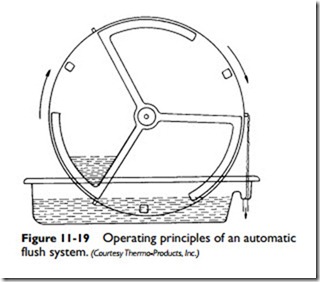Service and Maintenance Suggestions
Many service and maintenance instructions will be model specific. Whenever possible, read and follow the manufacturer’s instructions when servicing these units. If none is available, the instructions in this section will provide some guidance.
A humidifier equipped with a reservoir containing standing water should be regularly drained to remove lime and other residue. The first draining of the reservoir is recommended for 2 weeks after the unit has been installed or 2 weeks after the seasonal startup. Subsequent drainings should follow the schedule suggested by the manufacturer. A major problem with any humidifier is the buildup of lime or other mineral deposits in the water reservoir and on the evaporator pad. Manufacturers have attempted to minimize this problem by constructing the reservoir out of an extremely smooth material, such as an acrylic, so that these mineral deposits can be easily flushed loose during maintenance.
Some humidifiers are equipped with an automatic flush system to clean the mineral deposits from the unit. The components of a Thermo-Pride automatic flush system are illustrated by the schematic of a humidifier in Figure 11-19. The drum is the rotating pad with the flush wheel attached. As the drum rotates, water in the reservoir pan is scooped up into the flush wheel. The float assembly then permits fresh water to enter the pan to replace that which was scooped out (and which evaporated from the pad). As the flush wheel continues to rotate, the mineral-laden water scooped out is conveyed into the drain cavity of the pan and out the drain hose.
The mineral content of the water in the reservoir pan will be maintained at the lowest possible level with the operation of the automatic flush system.
A commonly used method for removing lime and other mineral deposits from the inside surface of the reservoir and the rotating evaporator pad is by cleaning these parts with muriatic acid (never with a detergent). Muriatic acid is an extremely efficient cleaning agent for this purpose, but it generates toxic fumes as it works on the deposits. For this reason, it is absolutely mandatory that the cleaning take place outdoors.
Note
A safer method of dissolving recently formed mineral deposits (although not as effective as muriatic acid or some of the special- purpose chemical cleaners) is by wiping them with a solution of 50 percent water and 50 percent vinegar. This is not effective on older deposits.
